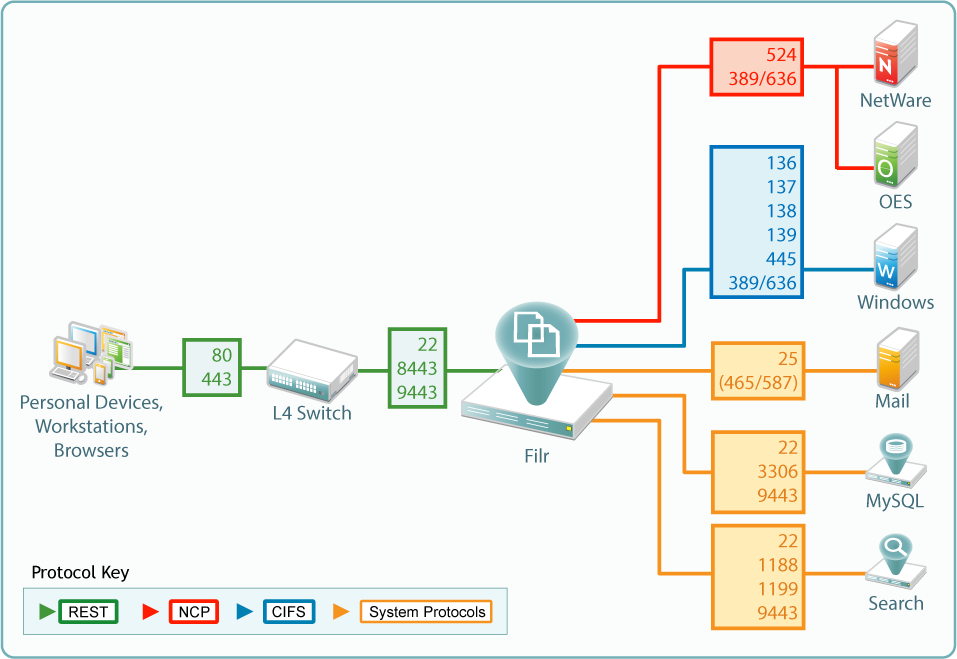4.2 Network Configuration
4.2.1 Changing the Network Configuration Settings
The default port that is configured when you install the Filr appliance is 8443. After the initial configuration of the Filr appliance (as described in Section 3.0, Configuring Filr for the First Time) you can make any necessary network changes.
To modify network configuration options:
-
Follow the steps in Section 4.1, Changing Configuration Options for the Filr Appliance.
You can modify the following configuration options:
Port Redirection: Select this option to have Filr automatically redirect from ports 80 or 443 (which are the standard ports for Web browsers) to ports 8080 and 8443 (which are the default ports that Filr listens on). Enabling port redirection in this way allows users to specify the Filr site URL without including the port number. If port redirection is not enabled, users must include the port number in the site URL when accessing the Filr site.
IMPORTANT:When port redirection is enabled, ensure that the reverse proxy ports are set to 80 for the HTTP port and to 443 for the secure HTTP port. If they are not, URLs that are sent with Filr email notifications will continue to have the default port (8443) in them.
For information about how to change the reverse proxy ports, see Section 4.7, Changing Reverse Proxy Configuration Settings.
HTTP Port: The default HTTP port is 8080. As a best practice, do not change this from the default port.
Select if you want to enable the HTTP port. By default, only the Secure HTTP port is enabled.
Select to force users to connect to Filr over a secure connection (HTTPS).
See Section 4.2.2, Port Numbers for more information about port numbers in Filr.
Secure HTTP Port: The default secure HTTP port for Filr is 8443. As a best practice, do not change this from the default.
See Section 4.2.2, Port Numbers for more information about port numbers in Filr.
Session Timeout: By default, if a user’s Novell Filr session is idle for four hours (240 minutes), Filr logs the idle user out. For increased convenience to Filr users, you can make the session timeout interval longer. For increased security for your Filr site, you can make the session timeout shorter.
Keystore File: Leave this field blank.
-
Click for your changes to take effect.
NOTE:This stops and restarts your Filr server. Because this results in server downtime, you should restart the server at off-peak hours.
4.2.2 Port Numbers
Table 4-1 lists the ports that you need to take into consideration when setting up Filr. Figure 4-1 is a graphical representation of how the ports are used in a Filr deployment.
As a best practice, do not change any port numbers from the default ports.
Table 4-1 Filr Port Numbers
|
Port Numbers |
Description |
|---|---|
|
80, 443 |
Standard Web server ports For more information, see HTTP Port:, Secure HTTP Port: and HTTP/HTTPS Ports When You Use NetIQ Access Manager with Filr. |
|
8080, 8443 |
Default Tomcat ports for the Filr appliance When you install Filr, Tomcat is installed along with the Filr software. Filr uses Tomcat as a stand-alone Web server for delivering data to Filr users in their Web browsers. For more information about Tomcat, see the Apache Tomcat Web site. For more information, see HTTP Port:, Secure HTTP Port: and HTTP/HTTPS Ports When You Use NetIQ Access Manager with Filr. |
|
8005 |
Default shutdown port For an explanation of the shutdown port, see Tomcat - Shutdown Port. |
|
8009 |
Default AJP port For an explanation of the Apache JServ Protocol port, see The AJP Connector. |
|
22 |
SSH port for the appliance |
|
9443 |
Jetty port for the appliance |
|
1199 |
Lucene RMI registry port |
|
1188 |
Lucene server port |
|
3306 |
MySQL outbound port |
|
25, 465 |
SMTP and SMTPS outbound ports |
|
524/tcp |
Access OES server over NCP |
|
137/tcp, 137/udp, 138/udp, 139/tcp, 445/tcp |
Access OES server over CIFS |
|
11211 |
Used for memcached caching in an appliance cluster |
|
636 |
Secure LDAP port |
|
389 |
Non-secure LDAP port |
Figure 4-1 Filr Port Usage

HTTP/HTTPS Ports When You Use NetIQ Access Manager with Filr
If you are fronting Filr with NetIQ Access Manager, ensure that you have configured the HTTP/HTTPS ports.
Configuring Filr in this way configures NetIQ Access Manager to access Filr over port 80, which is the standard port.
Port Configuration
Use the following port configuration when NetIQ Access Manager is fronting your Filr system on Linux:
HTTP Port: 80
Secure HTTP Port: 443
You need to make these configuration settings in the section. For more information, see Section 4.7, Changing Reverse Proxy Configuration Settings.